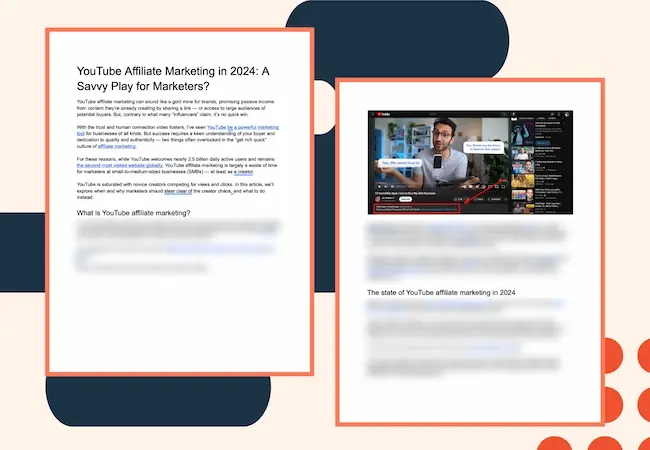Almost a year ago to the day, I found myself job hunting for the first time in a decade. It was unexpected. I didn’t have a current resume or a writing sample for job applications. Frankly, I was in over my head. And the market was ruthless.

If you’re reading this feeling the same way: There is light at the end of the tunnel.
Layoffs have been rampant in recent years, especially amid COVID-19 recovery. In the United States, unemployment sits at 4% — the highest rate in two years. But, at the same time, 270,000 jobs were created just last month. That includes the one meant for you.
An excellent writing sample can be the key to getting noticed. So, coming off my own nine-month job hunt (and now thankfully sitting in the position that gives me your eye today), I’m here to help.
Table of Contents
What is a writing sample?
A writing sample is a supplement to a job application that demonstrates your skills for positions that require a lot of writing (i.e. marketing, journalism, communications). It helps a company identify qualified candidates by demonstrating not only your writing skills, but how you think.
During my hunt, it wasn’t uncommon for a potential employer to ask for a writing sample.
I found that employers tend to request a writing sample in one of three ways:
- A long-form answer to a question on the application form
- 1-3 links to past work (or file attachments) on the application form
- A written assignment I completed a few stages into the hiring process
As a seasoned content marketer, I also had an appendix to my resume with links to my writing samples by default. But this isn’t necessary for every industry.

Like a cover letter or a resume, a writing sample helps a company identify qualified candidates no matter what form it takes. However, it’s uniquely important because it shows your skills in action more effectively than the former.
Like the samples at a local ice cream shop, they’re a delicious taste of what’s to come from you and help people decide if they want more.
Sound intimidating? Don’t worry — Not every job will require a writing sample, but they are common for journalism, marketing, public relations, communications, and research positions.
Employers might also ask for a writing sample if the role involves writing and communicating important information internally.
What do employers look for in a writing sample?
Employers look for different things in a writing sample depending on the role and industry you’re applying for. But typically, they all evaluate for tone, style, content, grammar, spelling, and punctuation.
They also may read between the lines — dissecting the strategy or value you deliver as well as your justification of it.
Company knowledge and brand voice may come into play as well. While these can certainly be learned later on, it doesn’t hurt if a candidate grasps these things from the get-go.
Cover Letter vs. Writing Sample
But Ramona, why do I need a writing sample if I already have a cover letter?
Well, first off, I know many of you probably aren’t attaching cover letters to every job application.

(Note: A hiring director once told me they’d never read a cover letter that sounded like someone was actually waiting for the job they applied for before mine. So, don’t let anyone tell you they don’t get read. Our templates can help.)
Second, the two documents accomplish different things.
Yes, a cover letter can showcase your writing skills and share credentials — but it’s all talk. It’s an elevator pitch of why you think you should be hired. A writing sample is proof.
It’s where you actually “walk the walk” and show an example of the kind of work you will actually deliver if hired.
Why do you need a writing sample?
Of course, many job applications simply require a writing sample. But as daunting as it may be as a candidate, it’s equally beneficial.
Submitting a writing sample for a job is a valuable opportunity to make the case for your employment.
Don’t have that much experience? Not the strongest interviewer? Even if you have trouble articulating why you’re a good fit for a position verbally (sometimes it’s hard under pressure, I get it), a writing sample actually demonstrates your capabilities. It does the talking for you.
How long should a writing sample be?
I’m not one for a word count. I always say just write as much or as little as you need to do a topic justice — but that’s not practical when applying for a job.
Employers, especially today, tend to have mountains of applications and writing samples to review and very little time to do so. So, practice some restraint.
My current job required an 800-word writing sample, and this Chatty Cathy topped out at 813 (with, admittedly, much difficulty).
The general consensus agrees with this length.
Hanne Keiling for Indeed summarizes it well, “In most cases, your writing sample should be around 750 words or between one and two pages. Like your resume, employers have a limited amount of time to review your writing sample. A brief, impactful writing sample is better than a long, less impressive one.”
What to Submit for a Writing Sample
What you submit as a writing sample for job applications may vary depending on the position. Perhaps the employer may even specify what they’d like to see.
For example, if you’re applying to be a movie critic, they may ask to see a few of your published movie reviews. If you’re applying for head of communications, you’ll likely send press releases or examples of emails.
For this role, I was asked to write a blog article on a specific marketing topic (obviously).

However, if the request is open-ended, here are some things you can consider including:
How to Choose What to Submit for a Writing Sample
Unless the employer requests something new, it’s best to lean into your existing work when submitting a writing sample.
Not only is this faster, but it also shows employers you have a history of good work. Not sure what you should submit for your next writing sample? Here are four things to consider.
1. The Position and Company
A writing sample for a job is only as good as its relevance. Study the job description thoroughly and think about any conversations you’ve had so far.
What skills are they looking for? What knowledge and experience do they want in a new hire? What do they have to accomplish? Choose writing samples that showcase these characteristics.
(Note: I remember a friend reviewing one of my writing samples for grammar before submitting and suggesting I cut a specific sentence for length. I didn’t listen. I kept it, knowing the hiring team mentioned certain criteria multiple times on previous calls. That sentence was called out and praised in a later interview.)
You also want to know the company’s brand, culture, and voice. Read their blog. Scroll through their social media. Check out their about us page, culture code, and media kit.

Submitting a writing sample that aligns with these elements will be that much more likely to resonate with your audience and show that you understand the organization on a deeper level.
2. How the Piece Performed
Sometimes, great content doesn’t perform well. Think about the genius movies that were duds at the box office or the iconic albums that flopped when released. Sometimes it’s about timing, competition, or, let’s be real, the algorithmic overlords.
However, choosing a writing sample that has accomplished a relevant goal can do wonders in helping you stand out.
When choosing a writing sample to submit, ask yourself these questions:
- What was the goal of this piece
- Is it relevant to the position?
- Did it accomplish the goal?
- What qualitative or quantitative results can I share?
If a piece of writing was high-quality and successful, it’s a strong contender.
3. Your Strategy or Thought Process
When considering a writing sample, ask yourself if it was strategically strong. Was your thought process or approach to writing particularly smart or forward-thinking?
When you submit a writing sample for a job, employers usually ask about it later in the hiring process.
Even if a piece didn’t necessarily perform well, make a case for why it was still a smart play. That’s all that matters.
A good writing sample showcases the way you think in addition to your writing skills.
4. Your Passion
I mentioned that a writing sample can do the talking for you. But if you can talk about the sample passionately, that’s a huge plus.
Again, this depends on the role. But sometimes, if you can confidently explain the piece, it’s worth submitting. Discuss your strategy, motivations, inspiration, subtle nuances, or meanings.
Samples like these show more of you as a person than just a professional. And, for companies that emphasize culture and values, this can be very persuasive. Amazon is one such company.

How to Write a Writing Sample
- Understand the role and assignment.
- Research the company and voice.
- Outline your piece.
- Write!
- Edit, edit, edit.

If you must create a fresh writing sample, try not to overthink it. The criteria above still stands.
You want the sample you create to:
- Be relevant to the job and company
- Accomplish the goals of the assignment (or role)
- Be strategic and thoughtful
- Show your passion and personality
With this in mind, follow these five simple steps to write your writing sample for a job.
1. Understand the role and assignment.
Read the job description, the assignment from the employer (if given), as well as any notes you have from interviews. These are what your writing sample must reflect to move into the next round; your “goals,” if you will.
Pro Tip: Indeed and Glassdoor are other places you can also turn to to gain insight into qualities your potential employer may be looking for. Check out the company’s page on those or other job sites and sort through similar job titles to see what you can find.
2. Research the company and voice.
Dig into the background of the company as well as its brand, voice, and culture. These will shape how you should be writing your piece.
Pro Tip: Search for existing examples of the content you’re creating from the company. For instance, when I was writing a sample article for HubSpot, I read several on the Marketing Blog, so I knew what style they liked.
If you’re interviewing for a public relations job, see what press releases are out there. Think about the assignment and position in question and head to Google.
3. Outline your piece.
Once you know what you need to accomplish, take some time to outline your piece. Include your key talking points, important supporting details (always have data or facts to support your claims or suggestions), any related research, and requirements from the employer.
Pro Tip: Outlines are one place AI excels. If you’re having trouble getting your thoughts together, try our Free AI Content Writer to get started.
4. Write!
This is self-explanatory, but sit down and write! Write like your job depends on it — because, well, it does.
Pro Tip: When writing, I try to give myself enough time to “walk away” from a project. In other words, I get a messy first draft out and then come back to review and refine with fresh eyes later. If time permits, I recommend you do the same. It’s amazing what a brief break can do for quality.
5. Edit, edit, edit.
Even if you don’t have the time to step away from your writing sample and return to it, make sure you re-read it from beginning to end.
Look at it with a critical eye. Check for the skills and requirements outlined by the employer, as well as basics like grammar, punctuation, narrative, and flow.
This is your chance to add anything that’s missing or remove anything that’s distracting from your main point, so don’t skip it.
Pro Tip: Reread the piece out loud. This is something several of my teammates and I do, and it’s one of the easiest ways to find fluff.
Put your job hunt on the ‘write’ path.
Submitting a writing sample for a job can be nerve-wracking at first. You could have hundreds of amazing works to your name, but it’s all coming down to this one document. That’s a lot of pressure, but give yourself a moment to feel it — and then get to work.
Use the tips and steps I outlined in this article for your writing sample, and I assure you, the right job will find you. Just like mine did.


![→ Click here to access 5 free cover letter templates [Free Download]](https://no-cache.hubspot.com/cta/default/53/3f347702-d7e9-4e59-9fe4-be4cd7bad191.png)



